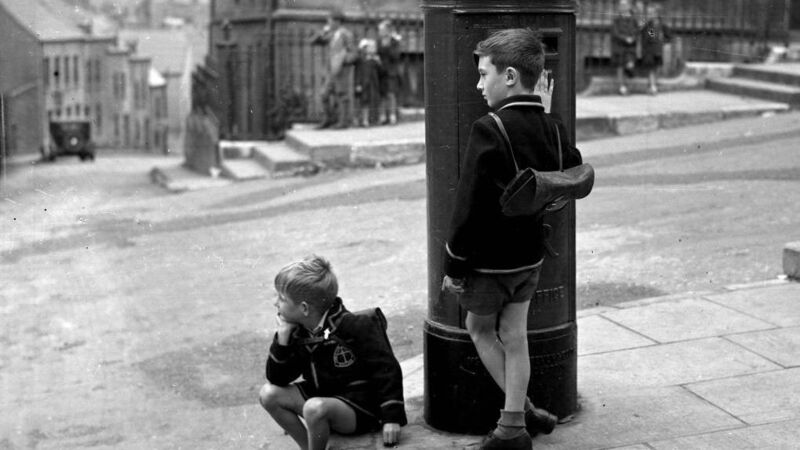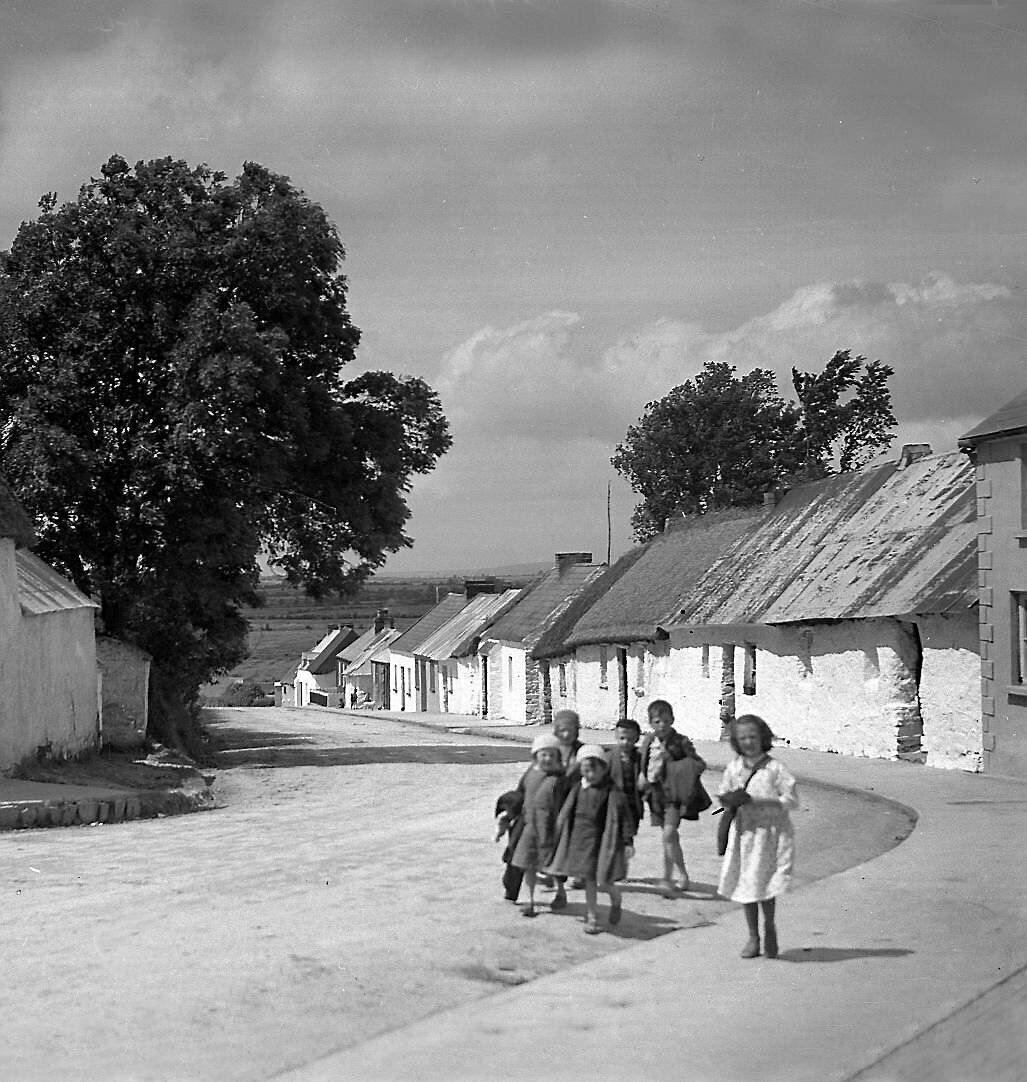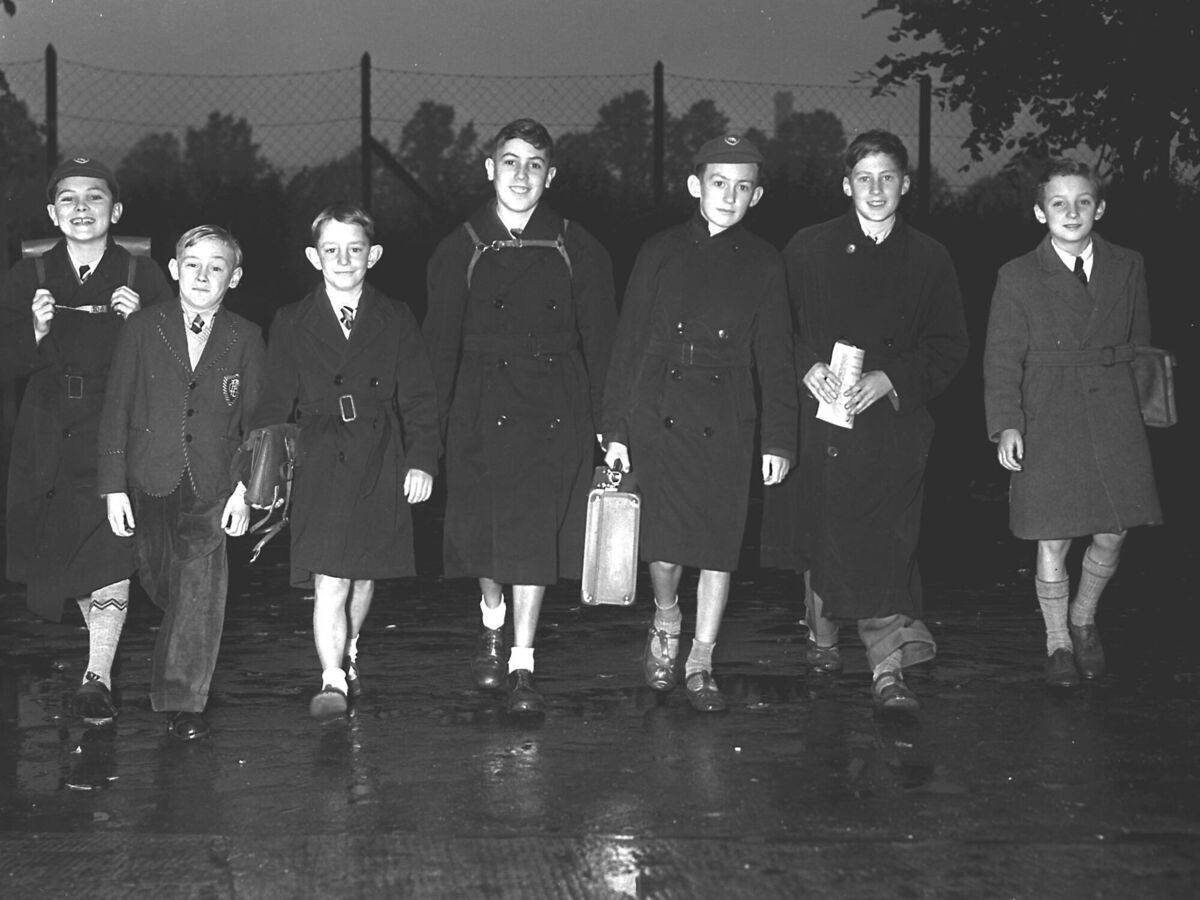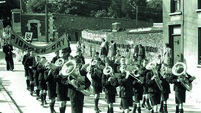Throwback Thursday: A lift into school? We walked or got the bus

Two boys from Christian Brothers College wait for a lift home from school during a bus strike in Cork city on September 4, 1947
It’s September, and all across Cork children have been returning to school. Some reluctantly, some actually looking forward to seeing all their classmates again, taking part in all the activities to be found there.
Parents are also getting themselves back into the strict routine after the more relaxed atmosphere of the summer. No more lazing in bed in the morning, everybody has to be up and doing at an early hour. Were those school shirts ironed? (Do modern shirts need to be ironed? Are they all drip-dry maybe?) Where did you put my clean socks? I can’t find my tie! Breakfast gulped, one eye on the clock, and then the school run, fitted in before office hours.
Back in the day, of course, children walked to school as a matter of course, or took a bus for longer distances.
Some readers of Throwback Thursday probably remember footing it right across the city in their younger days, and thinking nothing of it.
There were always interesting things to look at on the way, and on the journey home at the end of the day as well.
We know, we know, modern perceptions of safety decree that children should not be left to wander our streets on their own. They should be taken to the school gates, dropped off, and picked up again at the end of classes.
You have only to pass by any educational establishment at the correct hour to become entangled in a positive traffic jam of cars trying to find somewhere to park while waiting for their precious cargo.
Is it really essential to ferry schoolgoers to and fro all the time? Perhaps for the tots, yes, but surely a healthy teenager can make his or her way from home to educational establishment and back again?
Wouldn’t it be better for their health, their figures, their brains, if they were looking around them, being interested in what they saw, talking to their friends, arriving home eventually hungry and lively, rather than slumping into the back of a car and being decanted at the door, exchanging one enclosed space for another?
A countryman we spoke to some time ago remembered walking from the village of Waterloo down to the school in Blarney a long time ago.
“We would love the walk, in all weathers. You’d see the seasons changing, the buds coming out in spring and the birds nesting. It was special if you found a bird’s nest in the hedge on your way. You’d never harm it, but just look and enjoy seeing it.
“In autumn, you were keeping an eye out for the ripe hazelnuts falling, and the conkers too. And along the way there was a little spring just inside a gate, with lovely fresh cold water, and a little tin ‘ponny’ next to it, so you could have a drink if you felt thirsty.
“We knew that route like the backs of our hands, in every season. Those memories have stayed with me all my life.”
The most memorable story of those long-ago days belongs of course to Alice Taylor, whose To School Through The Fields enchanted everyone when it was first published back in 1988.
When the Innishannon author was invited to speak on Gay Byrne’s radio show, the whole country came to a halt, sat down, and listened to her soft voice recalling the past. The book has been a bestseller ever since.
It’s as if we all hark back to simpler times, when climbing over a ditch on your way to pick some wild flowers, noticing that there was a sheep straying, which involved calling in at the farm to tell them, meeting friends as they joined you from side laneways, was a normal part of the schoolgoing day.
Alice wrote that classic because she realised that the old ways had disappeared, and that today’s children can hardly believe that such things ever existed. She found this when talking to her own young family.
“When I explained that previous generations had grown up with no bathroom, no car, no telephone and no television, I could see that they were unable to imagine what that could be like,” said Alice.

“It felt as if I was weaving fiction. That made me realise that a whole generation had grown up with no idea of how their parents and previous generations had lived.”
Thanks be, Alice wrote not only that book but many more, all recalling to our minds an older, more peaceful Ireland, where the pace of life was so much slower, there was time to think and ponder, where the demands of the day were hard, but you could see the results in the land and the countryside around you.
If you have memories similar to Alice’s, then isn’t it time you wrote some of them down, shared them with others? If you aren’t up to writing that book yet, then tell us about them here.
Your memories may do a great deal of good in reminding everybody of simpler, more relaxed days, when your sleep was all the sounder for having done a hard day’s work – yes, and you walked to and from school as well!
Did you enjoy your own schooldays back in the 1950s or ’60s? Do you have bad or good memories of classes, homework, particular teachers?
In particular, do you believe the oft-quoted phrase that these were ‘the happiest days of your life?’ This writer could never understand that in childhood. School was complicated, restricting, boring, unpleasant, something to be escaped from at every possible opportunity. How could those days be happy?
Of course, you realise as you grow older that the trite phrase refers to an adult’s view of the child’s schooldays.
What a great life they have, thinks the parent who is fretting over jobs, mortgages, the cost of living, groceries, new uniforms, or house repairs. All they have to do is swan off to school in the morning, play with their friends, and come home expecting good food on the table. Isn’t it fine for them?
Ah yes, new uniforms. Whoever was it, we wonder, that first invented the most unattractive, unflattering garment ever known, the girl’s school gymslip? Yards of expensive material pleated into a restricting coverall that denied any form of individuality or indeed comfort.
Boys were relatively fortunate in only having to wear blazers and caps over shirt and trousers, but girls were condemned to that ghastly gymslip for years.
“Oh I remember when we got to 5th year, we were actually allowed to take the gymslip apart and make it into a skirt,” says Katie O’Brien.
“My mother helped me, but I was so thrilled that I did most of the work myself on our old family treadle machine.
“There were yards of a ghastly green woollen weave in that gymslip, plenty for a fairly full skirt. It made such a difference when we could appear in front of our friends looking reasonably attractive!”
Katie laughs as she recalls visiting Kerry Woollen Mills many decades later and discovering a whole roll of that appalling tweed, woven especially for her school.
“Seeing it again brought back all the horror of those uniform days!” she said.
But at least, Katie adds, she can still tie a tie with the best of them. “You got used to doing that double-quick every morning of the term.”
Did you have a school uniform you loathed? Was there some bully who always snatched your cap, so you had to go home and confess the loss, involving your parents in more expense? Do you remember those self-same parents bemoaning the cost of a new blazer which you simply had to have for the school sports day or risk being not allowed to attend?
At least today, girls are as likely to be in trousers as in gymslips, and school sweaters have become slightly more colourful.
Now - do you know the Schools Collection?
It was a brilliant idea thought up by the very new Irish government in the 1930s, when it was feared that being under English rule for so long had resulted in the loss of much of our own traditional culture.
Children all over the country were told to go home and record the memories of the oldest person they knew – a grandparent, a great-grandparent, a nearby friend, anybody who remembered the older days - ie, the latter half of the 19th century. Legends, songs, beliefs, folk cures, memories, anything.

And so they did, and brought the results to school where they were recorded in the very best copperplate handwriting for future generations.
That Collection is now online with Duchas.ie and is worth consulting at any time for the marvellous insight it gives you into that older Ireland.
Did they mention schools of former times? They did indeed. Here is one memory from Reentrusk down on Beara where the informant, a Mrs Sullivan, then aged 72, is remembering what she herself had been told in her own childhood.
“Long ago, there was a school in the townland of Boloughacahireen. It was whitewashed outside and inside and there was a slate roof on it. The teacher used teach the children in the school.
“The subjects she used teach to them were reading, writing, arithmetic, history and geography. They didn’t speak Irish in the school because the teacher didn’t know it.
“They had copy-books and writing pens and they had slate and slate pencils for doing sums. There were six or seven desks in the school. The name of the teacher was Miss Regan and she was a very learned teacher.”
And here is another memory on the fascinating topic of hedge schools, gathered in Caher, Co. Cork.
“There was a hedge school in Lower Letter once upon a time. There was but one teacher in it, his name was Timothy McCarthy. There were no windows but one door and one chimney in it. It was English that was taught in the school but sometimes the prayers were taught in Irish.
“The teacher liked the Irish but it was not spoken in teaching anything except the prayers. The children wrote with pencil and slate. There were no pens nor paper at that time.
“The scholars paid the teacher once in the three months. He got three shillings from every scholar at the end of that time. There were no schools held in farmer houses. The teacher had a house of his own and he came home every night.
“There was a black board in the school and a few long seats for the children to sit on. There was one fire in it. English, Arithmetic, Geography and Irish prayers were taught in the school.”
It is clear from this account that hedge schools were not, as claimed scornfully by the colonists, harsh dwellings underneath a bush, but real buildings, albeit poor enough ones. It’s relevant to note that the teacher liked Irish, but it wasn’t taught, except for prayers.
There are such riches to be found in the Schools Collection that every single one of you should make it your business to look it up right away.
Want to know how the Pouka used to treat his victims? What the Banshee really sounded like? How much work a small boy or girl had to do in the early morning before even setting out for school? Go look it up this minute!
And let us know your own memories of your schooldays, whether it was a happy time in a baby class or the terror of moving into secondary school among strangers.
Email jokerrigan1@gmail.com or leave a message on our Facebook page: www.facebook.com/echolivecork.







